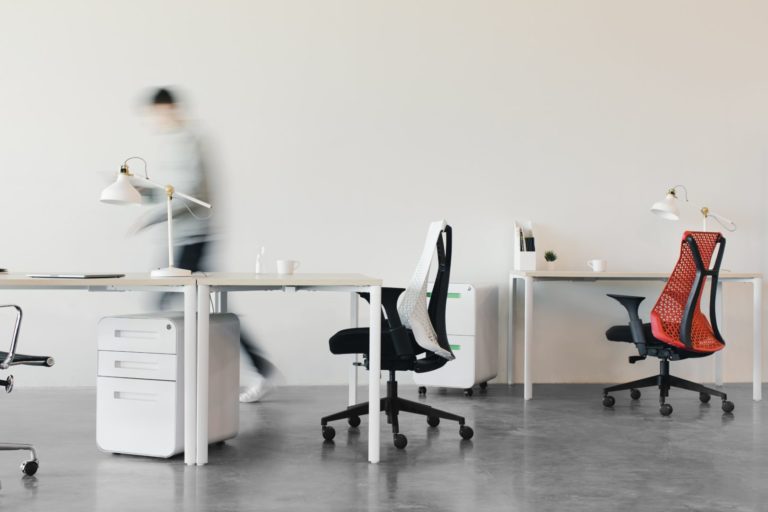Chair ergonomics is something you are quite possibly experiencing at this very moment while you read this article. I thought it would be appropriate to be kick off our education series with this topic. Industrial design is a broad subject with many areas of expertise within it.
We’ll be diving into different products and discussing their ergonomics from both a user and a design perspective. While the mechanical engineering isn’t heavy in a product like this, industrial design does a ton of work.
A lot goes into design when it comes to products that interact with the body, especially for long periods of time. Here we’re going to talk about chair ergonomics, specifically office/work chairs.
Choosing an ergonomic chair doesn’t really cross the mind until the pain of sitting in an uncomfortable chair starts to weigh upon your work, health, and sometimes your overall happiness. What does it mean when someone says “ergonomic”.
We almost all know the word, and know that it has something to do about a product being comfy or nor hurting. Ergonomics is the science of fitting the task to the worker to maximize productivity while reducing discomfort, fatigue and injury. You can of course replace the word worker with user and sometimes remove productivity depending on the product.
Discomfort will affect your work (or fun) and it’s a good designers job to make sure discomfort isn’t a part of a product or process. Ergonomic chairs are designed to suit a range of people; however, there is no guarantee that they will suit any one person in particular.
For example, a chair could be too high and the arm rests too far apart for a short, slim person, but fit an average height and size person just fine. In addition, chairs may not suit every task or arrangement at the workstation, or it might not even be for a workstation. A chair becomes ergonomic only when it specifically suits a worker’s size.
BLANK
Ian Peterman, CEO Tweet

Specific Design Points

Adjustability – Check to see that seat height is adjustable.
Seat height range – Check whether the seat height can be adjusted to the height recommended for the worker who will use it. Other chairs may have to be selected for very short or tall workers.
Backrest – Check to see that the backrest is adjustable both vertically and in the frontward and backward direction and has a firm lumbar support.
Seat depth – Select the seats that suit the tallest and the shortest users.
Stability – Check for the stability of the chair; a five-point base is recommended.
General Design Ideas
BLANK
Ian Peterman, CEO Tweet
- One chair does not fit everyone. The user’s body dimensions must be used when selecting a chair so that it does not strain one part of the body while fitting another
- Collect data about the user’s body height. The optimal seat height is about one quarter of the body height. This is only a rule of thumb since the torso-to-leg ratio can vary widely
- There is no chair suitable for every activity. For example, dentists require a different chair than do industrial workers or computer operators
- Consider maintenance and repair costs. Check with the manufacturer for items to inspect for and how often inspection should be done

Chair Selection and Fitting

While selecting a chair, keep your chest open and relax the shoulders while making chair adjustments. Thighs are parallel to the ground and both feet are placed directly and securely on the floor, not dangling on the foot ring.
BLANK
Ian Peterman, CEO Tweet
When designing a work chair, several basic concepts should be considered:
- Height off the ground
- Armrests or not
- Curve of the backrest
- Adjustments for a wide range of body types
- Adjustable back-seat mechanism for supporting the spine
- Material choices
- Wheels or not
- Range of seat motion – does it lean back, turn 360°, etc.
Ergonomics play a huge factor in our comfort level and selecting the chair we work in 8+ hours a day correctly is very important as a user. Chair ergonomics play a role in the comfort and health of workers around the world. As designers, when we design a work chair, we have two options. The first is to take in the wide diversity of humans and find ways to accommodate as many shapes and sizes as possible to allow the product to help as many people as possible.
BLANK
Ian Peterman, CEO Tweet

The second is to select a very narrow group of people and create a perfect chair for them. Ergonomics is its own science, not just a cool word we use (though it does sound cool), and we’ll be discussing it more through this series. We hope you’ll learn a bit about what we do and how we do it.
Your Next Steps
Related Conscious Design BLOG Posts
What’s a Feasibility Study?
A feasibility study is a very important step in making sure a product will be successful. I break down what they are and why they matter.
What it Takes to Develop a Smart Product
As the Internet of Things has grown over the years, smart products have become a pretty hot item. Many people have product ideas for turning
5 Tips for Market Research & Analysis
Wondering about Market Research & Analysis? This will give you a few tips on what it is and how to start your own research.


